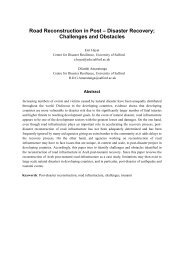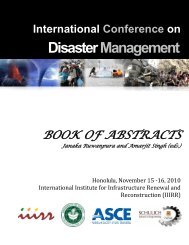Detection of Flood affected areas of Kalutara District of Sri Lanka by ...
Detection of Flood affected areas of Kalutara District of Sri Lanka by ...
Detection of Flood affected areas of Kalutara District of Sri Lanka by ...
You also want an ePaper? Increase the reach of your titles
YUMPU automatically turns print PDFs into web optimized ePapers that Google loves.
<strong>Detection</strong> <strong>of</strong> <strong>Flood</strong> <strong>affected</strong> <strong>areas</strong> <strong>of</strong> <strong>Kalutara</strong> <strong>District</strong><br />
<strong>of</strong> <strong>Sri</strong> <strong>Lanka</strong> <strong>by</strong> Using PALSAR Remote Sensing and<br />
GIS Technology<br />
Ajith Rohana Gunawardena<br />
Central Environmental Authority, <strong>Sri</strong> <strong>Lanka</strong><br />
ajith@cea.lk<br />
Abstract<br />
<strong>Flood</strong>s and droughts are more frequently experienced natural hazards in <strong>Sri</strong> <strong>Lanka</strong> These<br />
hazards have a strong impact on the country’s socio-economic environment. The government<br />
spends large amounts <strong>of</strong> money annually to provide relief to families <strong>affected</strong> <strong>by</strong> natural<br />
hazards. <strong>Flood</strong> hazard ranks high among natural hazards in <strong>Sri</strong> <strong>Lanka</strong>. Comparing with the other<br />
districts <strong>of</strong> the country, <strong>Kalutara</strong> district severely subjects to floods. The floods in May 2003<br />
recorded highest damage since 1992. The heavy rainfall caused severe impact on lives and<br />
economic assets <strong>of</strong> the people. The floods occurred in June 2008 also was serious after the<br />
floods in May 2003.<br />
<strong>Kalutara</strong> district is subjected to regular flooding particularly with heavy rains in the upper<br />
catchments <strong>areas</strong> <strong>of</strong> the Kaluganga, damaging houses, urban centers schools the roads network,<br />
home gardens, crops, industries and etc. As such inhabitants <strong>of</strong> this district have been badly<br />
<strong>affected</strong> <strong>by</strong> frequent floods. Their livelihood and social life have been disturbed. So far, no<br />
specific adaptation or mitigatory measures have been taken in this regard.<br />
Keywords: floods, droughts
1. <strong>Detection</strong> <strong>of</strong> flood <strong>affected</strong> area and development <strong>of</strong><br />
flood map<br />
To having a flood <strong>affected</strong> and vulnerability area map is very important tool to environmental<br />
management as well as after flood management practices. However, development <strong>of</strong> such map<br />
<strong>by</strong> field work is very difficult and time consuming task .To overcome above limitations,<br />
RADAR satellite images and GIS technology can be used to develop flood <strong>affected</strong> area map.<br />
2. Objective<br />
The main objective <strong>of</strong> this study are to prepare a flood map <strong>by</strong> using PALSAR (Phase Array L<br />
band Synthetic Aperture Radar) Remote Sensing and GIS Technology and flood risk map for<br />
<strong>Kalutara</strong> district overlaying with other map features such as road net work, land uses,<br />
population, transportation, schools, industries and etc. and explore impact on people who live<br />
there .<br />
Once this flood risk map is produced it could be utilized for planning sustainable project,<br />
identification <strong>of</strong> vulnerable people and resources in the flooding <strong>areas</strong> and also for preparation<br />
<strong>of</strong> disaster preparedness plan. The Central Environmental Authority (CEA) as a regulatory<br />
authority concerned with conservation and management <strong>of</strong> the environment in <strong>Sri</strong> <strong>Lanka</strong><br />
3. Methodology<br />
ALOS PALSAR 1.5 satellite images taken on 03, June.2008 (peak flood period) and on 14<br />
Aprial,2008 ( Non flood day) were used to prepare flood map. According to the situation<br />
report- 2008 <strong>of</strong> Disaster Management Center, <strong>Kalutara</strong> was one <strong>of</strong> the most effected districts in<br />
the Western province due to torrential rain resulting from the South West monsoon and it has<br />
been experiencing flood situation since 30th May 2008.<br />
Acquired images on 03 rd , June were geometrically rectified into UTM (Universal Transverse<br />
Mercator) projection and datum WGS 84 (zone 44) using ground control points obtained<br />
through GPS together with 1: 50,000 topographic maps. Then the image was subjected to<br />
unsupervised classification to obtain 10 different classes According to the color variability flood<br />
<strong>affected</strong> layer was identify <strong>by</strong> visual interpolation and developed a flood <strong>affected</strong> area layer on<br />
the map. Previously collected GPS locations were used to check the accuracy <strong>of</strong> flooded area in<br />
the map.<br />
Same procedure was followed for the images taken on non-flood day (14 th ,April) to produce<br />
existing water layer (water bodies and ways) and it was overlaid with the flood layer and<br />
extracted actual flood <strong>affected</strong> area to developed the final flood map.The produced flood map<br />
was overlaid with other relevant map layers such as administrative boundaries, road net work,<br />
and school. Industries, land uses and etc. to explore the impacts on people due to flood.
4. Data and material and s<strong>of</strong>tware used<br />
ALOS PALSAR 1.5 satellite images, 1:50,000 topographic maps, ArcGIS, ERDAS, Remote 10,<br />
Adobe Photoshop s<strong>of</strong>tware and GPS data were used to this project analysis.<br />
5. Results and discussion<br />
It is estimated that 7.28 % <strong>of</strong> the total land area <strong>of</strong> the <strong>Kalutara</strong> district has been inundated<br />
during the flood occurred in June, 2008. When contour layer is super imposed on flood map<br />
prepared, it is shown clearly that low lying area <strong>of</strong> the study area has been inundated and most<br />
<strong>of</strong> these lands are located in closed proximity to the coastal area. Generally majority <strong>of</strong> the lands<br />
<strong>of</strong> the <strong>Kalutara</strong> district are high elevated ones. Therefore, severity <strong>of</strong> the flood may be much<br />
higher in these low lying <strong>areas</strong> and also comparing with the flood damages in the other districts<br />
<strong>of</strong> <strong>Sri</strong> <strong>Lanka</strong>. Highest percentage <strong>of</strong> flooded area covered <strong>by</strong> paddy fields (about 52.67 % ) and<br />
followed <strong>by</strong> Rubber (25.34%) , Home gardens ( 15.8% ) and it can be observed that some<br />
where <strong>of</strong> all class A and B roads and minor road <strong>of</strong> the district have been submerged <strong>by</strong> flood<br />
water. Therefore, the accesses to most <strong>of</strong> the non-inundated <strong>areas</strong> have also been <strong>affected</strong>.<br />
Figure 1: <strong>Flood</strong> <strong>affected</strong> area map <strong>of</strong> <strong>Kalutara</strong> district developed using PALSAR remote sensing<br />
technology
6. Conclusion<br />
The flooding map made <strong>by</strong> analyzing the satellite image taken during the real flood time and<br />
the flood risk map prepared <strong>by</strong> overlaying with other relevant map layers create very<br />
comprehensive and accurate information / data with less effort and less time . The flood risk<br />
map shows actual situation <strong>of</strong> the area , land uses inundated, <strong>affected</strong> industries, schools, road<br />
net work, important eco-systems and etc. during the flood.<br />
Finally, Considering the usefulness <strong>of</strong> these data / information derived under this study , it is<br />
recommended that this type <strong>of</strong> GIS based studies should be extended to the other part <strong>of</strong> the<br />
country to identify the real effect <strong>of</strong> flood as well as other disasters , impacts on people and to<br />
prepare adaptation/mitigation and rescue plans.
















